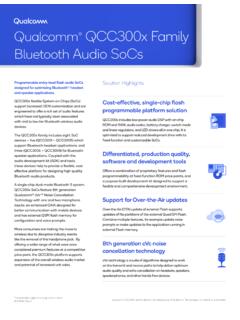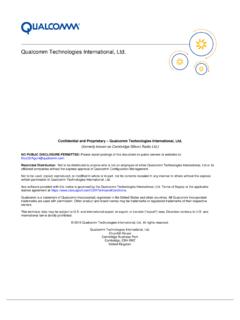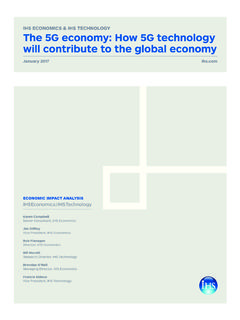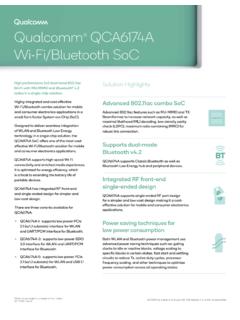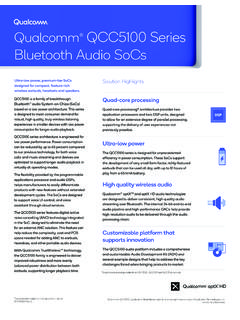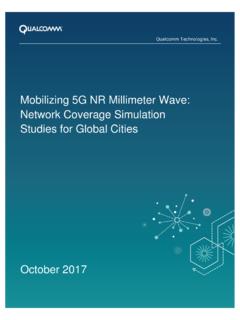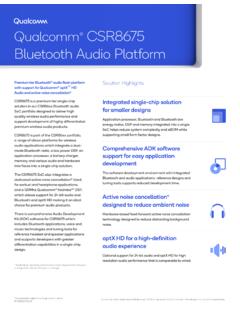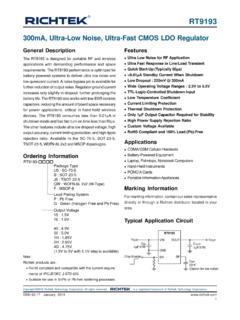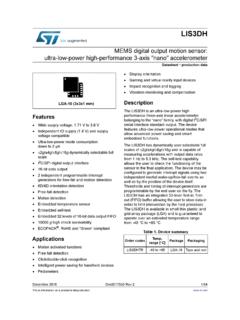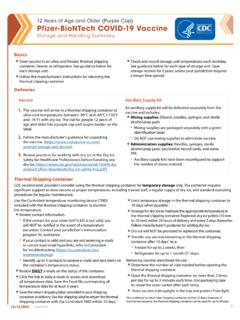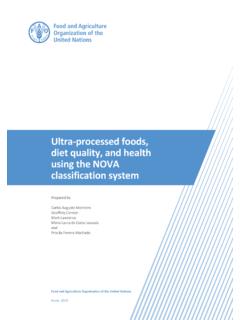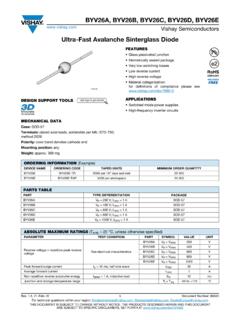Transcription of Ultra-Reliable Low-Latency 5G for Industrial Automation
1 ` Independent market research and competitive analysis of next-generation business and technology solutions for service providers and vendors Ultra-Reliable Low-Latency 5G for Industrial Automation A Heavy Reading white paper produced for Qualcomm Inc. AUTHOR: GABRIEL BROWN, PRINCIPAL ANALYST, HEAVY READING HEAVY READING | QUALCOMM | Ultra-Reliable Low-Latency 5G FOR Industrial Automation 2 5G FOR Low-Latency Industrial NETWORKS The first specifications for 5G New Radio (NR) have been agreed, and commercial 5G mobile broadband services are expected to launch in 2019. 5G NR, however, will enable many more commercial opportunities. This white paper discusses how, using the Ultra-Reliable Low-Latency communication (URLLC) capabilities of 5G, operators and enterprises can address diverse, high-performance use cases linked to Industrial Automation .
2 This is part of a broader oppor-tunity often described as Industry-X, Industry or the Industrial Internet. The paper focuses on the "factory of the future" concept and uses robotic motion control as an example of an application with extreme performance requirements. It shows how 5G can contribute to more efficient and flexible production processes and emphasizes how important it is that 5G integrates with existing, and emerging, Industrial networking standards to make this transition faster and more effective. Local-area networks based on wired Ethernet, WiFi and LTE are already used for Industrial applications and provide a starting point for more demanding, transformative Automation using 5G. Private, exclusive-use networks give the enterprise the ability to configure the network to exactly the performance it requires.
3 Because it is not dependent on interworking with public networks, and because the factory owner has full control of the deployment envi-ronment, Industrial networks can be designed and optimized for real-time performance, for extreme reliability and availability, and for stringent privacy and security restrictions. 5G & Industrial Automation By design, and partly through fortune, 5G wireless technology is under development at a time when many industries are themselves transforming through greater Automation using tech-nologies such as the Internet of Things (IoT), machine vision, machine learning and robotics. The "factory of the future" is part of this broader trend and incorporates several use cases with differing performance requirements and desired outcomes.
4 Figure 1 shows three high-level categories of networking for factory Automation that can be enabled by 5G: 1) real-time processes; 2) non-time-critical processes; and 3) broader enterprise communications. Each of these categories contribute to the better running of the factory, or similar Industrial facilities, such as warehousing, logistics or extractive industries (mining, oil & gas, etc.). Figure 1: 5G & Factory Automation Processes Use-Case Category Scenario Impact Time-critical processes Real-time, closed-loop robotic control Video-driven machine-human interaction AR/VR for maintenance & training Increased efficiency safety Non-real-time processes inside factory Tracking products & machine inventory Non-real-time sensor data Remote inspection & diagnostics Optimized management of production facilities Enterprise communication Logistics & warehousing Employee & back-office communications Tracking goods post-production Improved business operations Source.
5 Heavy Reading, adapted from 5G-PPP "5G and the Factories of the Future" HEAVY READING | QUALCOMM | Ultra-Reliable Low-Latency 5G FOR Industrial Automation 3 The most demanding use cases are time-critical processes, of which robotic motion control, with a 2 ms "cycle time" and very low error rate, is an exemplar. In many production lines, human workers will also be involved, and the concept of co-working with machines some-times known as "cobotics" also requires extremely low latency, perhaps also using machine-vision video, to detect humans and ensure safety. These types of Low-Latency , high-reliability applications are difficult to deliver without a local-area 5G network. There are many other types of in-factory process that are also critical to operations, but not time-critical at the millisecond or microsecond level.
6 For example, tracking parts, machine inventory and finished products through the production process into the logistics chain and, potentially, beyond the factory into the market. Sensor data, such as that used for energy and environmental monitoring, is similarly important, but doesn't require real-time processing and millisecond networking. Many of these use cases also have high-density operation in common, where 5G, by design, has major advantages over existing technologies. Industrial Ethernet & 5G NR Many Industrial processes are already substantially automated, and companies continue to pursue greater efficiency, production speed and yields through new technology. 5G does not itself define Industrial processes; it can, however, be an enabler of new operating models.
7 In the first instance, the 5G network should replicate the functionality of wired systems to support existing controllers, switches, sensors and actuators. In the second, there is an opportunity to make 5G integral to the evolution of Industrial Automation as machines, processes and production lines are themselves redesigned and improved. There are several Industrial Ethernet systems such as Sercos, PROFINET and EtherCAT designed for communicating with Industrial equipment and capable of real-time control of robotic equipment ( , within a 2 ms cycle time). One of the drawbacks of these systems is that they require physical cabling between machines, which means cables need to go through hazardous areas and may connect to moving parts, increasing the risk of failure and the need for maintenance.
8 It also means the production line is a fixed configuration that cannot be easily reconfigured to make more efficient use of machinery, or to adapt to changing demand. An immediate opportunity, therefore, is to use 5G to replace existing wired local-area net-works already deployed in factories. LTE and WiFi can do some of this with private LTE networks offering performance advantages over WiFi but generally don't support the necessary Layer 1-2 performance (scheduling, latency, jitter, redundancy) needed for the most demanding applications. 5G can, as demonstrated by testbeds and proofs-of-concept, meet these time-critical requirements. An important aspect of applying 5G to Industrial Automation is knowing which standards should be part of the design brief.
9 It is the responsibility of the industry verticals (factory owners, in this case) to communicate their priorities. A promising development is the emer-gence of the 5G Alliance for Connected Industries and Automation (5G-ACIA), an industry group that is working to align requirements from different companies and sectors. One ex-ample of this is how the "Industry " cohort of companies has proposed to use the IEEE Ethernet standard known as Time-Sensitive Networking (TSN) for Industrial networking. With many of the legacy Industrial Ethernet protocols able to run over TSN, designers of 5G systems can therefore now focus on mapping TSN to the 5G radio interface. This greatly simplifies integration work and will accelerate development of Industrial wireless networks.
10 HEAVY READING | QUALCOMM | Ultra-Reliable Low-Latency 5G FOR Industrial Automation 4 Industrial IoT PERFORMANCE REQUIREMENTS Factory-of-the-Future End Point Connectivity Future factories incorporate many digital processes (use cases), which can benefit from mo-bile connectivity on locally deployed, private networks. Figure 2 shows a selection of these use cases and devices, with their associated performance requirements. Figure 2: Overview of Wireless Connectivity Requirements Source: Qualcomm This diversity of device types from sensors to automated guided vehicles (AGVs), to un-tethered AR/VR, to security cameras, and robotic control generates different requirements for mobility, throughput, density, latency, power and availability.
